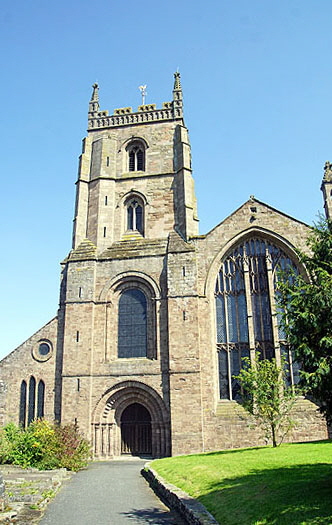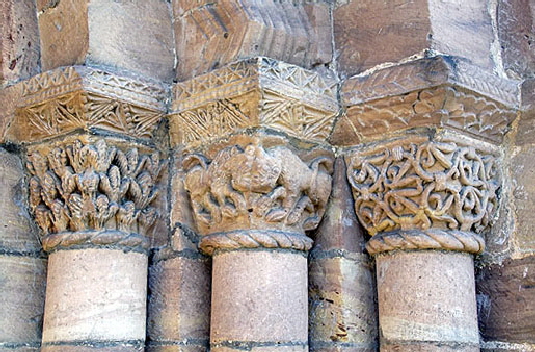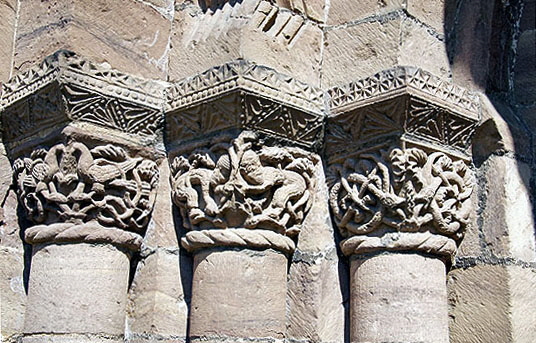|
|
||||||||||||||||||||||||||||||||||||||||||||||||||||||||||
|
Please sign my Guestbook and leave feedback |
||||||||||||||||||||||||||||||||||||||||||||||||||||||||||
|
Recent Additions |
||||||||||||||||||||||||||||||||||||||||||||||||||||||||||
 |
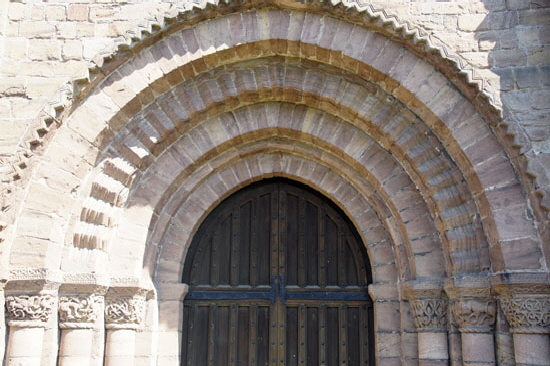 |
|||||||||||||||||||||||||||||||||||||||||
|
Left: The church from the south west. For all the world this looks like a pure Gothic church. Right: The west door which was the work of the Herefordshire School. Note the carved capitals. |
||||||||||||||||||||||||||||||||||||||||||
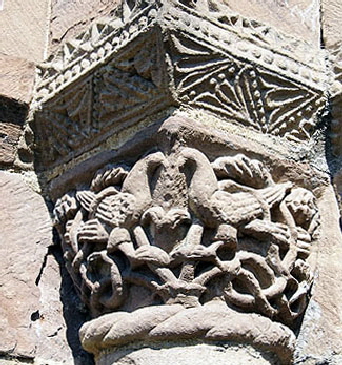 |
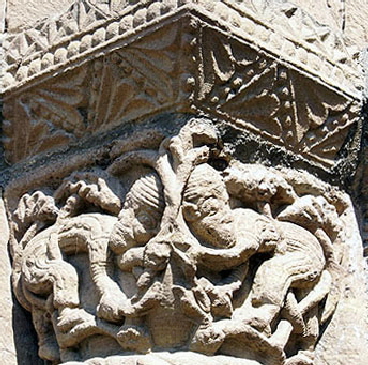 |
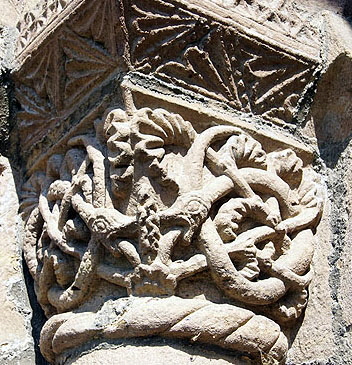 |
||||||||||||||||||||||||||||||||||||||||
|
The north side capitals on the north door are exciting indeed. Left: A pair of birds in what now must be called the characteristic Herefordshire style, although these two are rather more imposing than some others. They are entwined in vegetation. Centre: These two men are cutting away the foliage that surrounds them. They wear curious beehive-shaped headwear. Similar can be seen on the tympanum at Billesley, Warwickshire. Billesley’s tympanum is something of a mystery as it lies well outside the normal Herefordshire stamping grounds and is clearly by the same mason who carved the wonderful font at Eardisley in Herefordshire nearly seventy miles away/. Right: Two serpents also entangled in foliage. Malcolm Thurlby suggests that, as you read the composition as being men fighting towards the doves that are symbols of purity (and they do look like doves) escaping from evil embodied in the serpents. The renowned George Zarnecki suggested this as the most plausible interpretation of the Billesley font and the parallels in the imagery are indisputable. |
||||||||||||||||||||||||||||||||||||||||||
 |
||||||||||||||||||||||||||||||||||||||||||
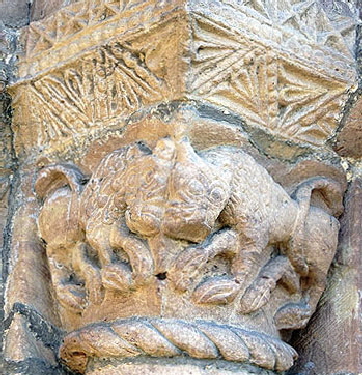 |
||||||||||||||||||||||||||||||||||||||||||
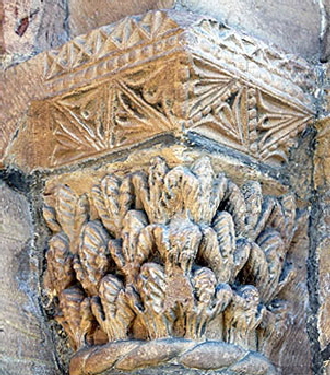 |
||||||||||||||||||||||||||||||||||||||||||
|
The capitals to the right of the west door are somewhat less flamboyant than the left. Left: The innermost sculpture is of stylised foliage which Thurlby says “has no parallel within the Herefordshire School. Centre: The middle capital has two “affronted” lions. Their facial features are very similar to those on the Shobdon font. Right: The outer capital has uninhabited strands of vegetation. For reasons that at unknowable the abacus has a different design to the other five of the west door. |
||||||||||||||||||||||||||||||||||||||||||
 |
||||||||||||||||||||||||||||||||||||||||||
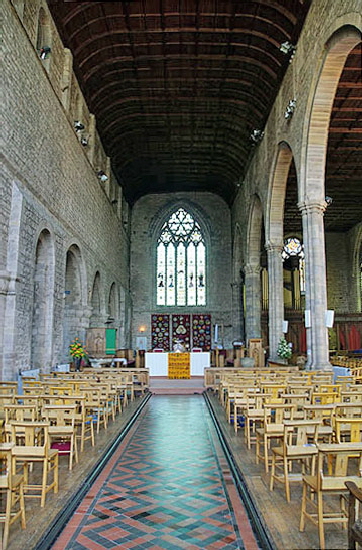 |
||||||||||||||||||||||||||||||||||||||||||
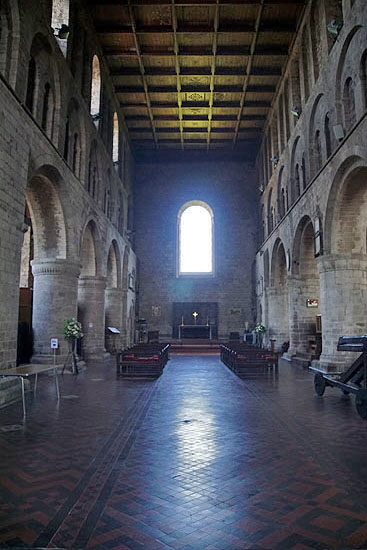 |
||||||||||||||||||||||||||||||||||||||||||
|
Left: The original Norman nave looking east. Note the size of columns which are necessary to support the height of the walls. Like most Norman abbeys and cathedrals (but not parish churches) the nave walls have three stages: arcade, triforium and clerestory. Centre: The three vertical stages of the original nave. Although the triforium (middle stage) arches have been filled in, those of the clerestory (top stage) would never have had a window in each archway. Beyond you can see the two parallel south aisles with the fine Decorated style windows clearly visible in the background. Right: The original south aisle which was rebuilt in 1239 and confusingly designated as the south nave. Possibly this was to allow further segregation between the monastic and town congregations. The Church Guide suggests that the east end was windowless because it would have abutted the south transept. That idea is supported by the east window which is clearly later. To the left is the Norman arcade of the original aisle but there is no sign of the Norman triforium from this side of the wall because it has been walled off (centre picture). To the right is the arcade through to the new south aisle. that was added in the fourteenth century. There could not be a starker illustration of the development of the church arcade between the twelfth and fourteenth centuries. |
||||||||||||||||||||||||||||||||||||||||||
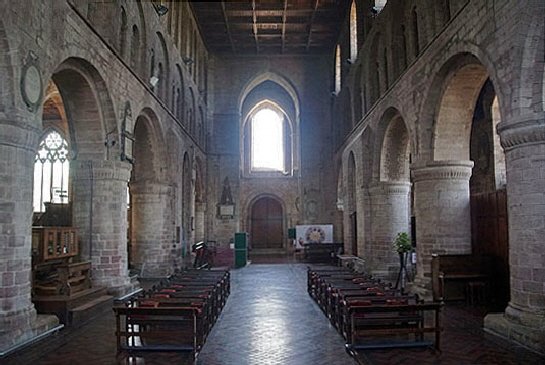 |
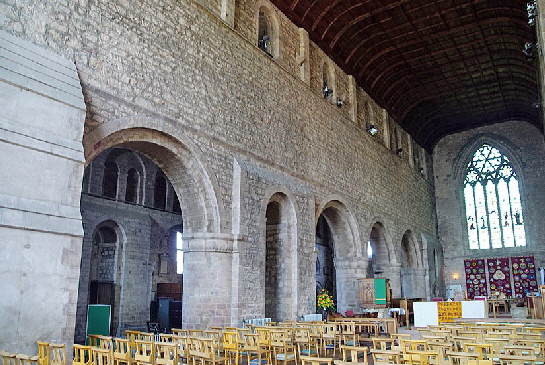 |
|||||||||||||||||||||||||||||||||||||||||
|
Left: The Norman nave looking towards the west. Right: The south wall of the Norman nave as seen from the south west. |
||||||||||||||||||||||||||||||||||||||||||
 |
 |
|||||||||||||||||||||||||||||||||||||||||
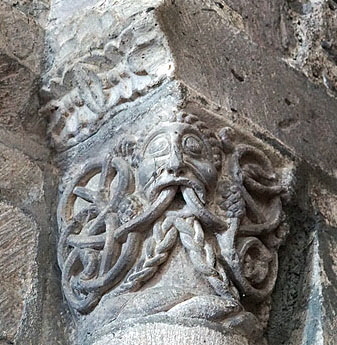 |
||||||||||||||||||||||||||||||||||||||||||
|
The inside of the Norman west door also has carved capitals by the Herefordshire School and this is a very unusual arrangement. Two of these (left and centre) have “masks” with protruding vine tendrils and grapes: one is vaguely human and the other manifestly grotesque. They are out of the “Green Man” tradition of carving and we still struggle to understand this most ubiquitous of icons. Right: A simple interlace design. |
||||||||||||||||||||||||||||||||||||||||||
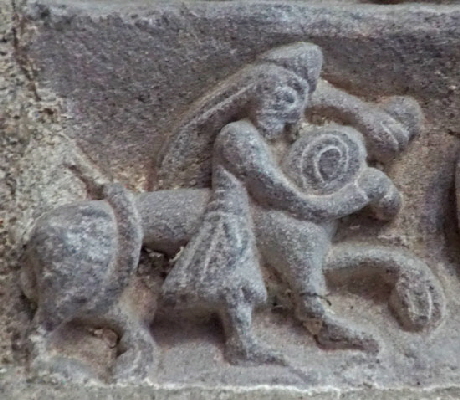 |
||||||||||||||||||||||||||||||||||||||||||
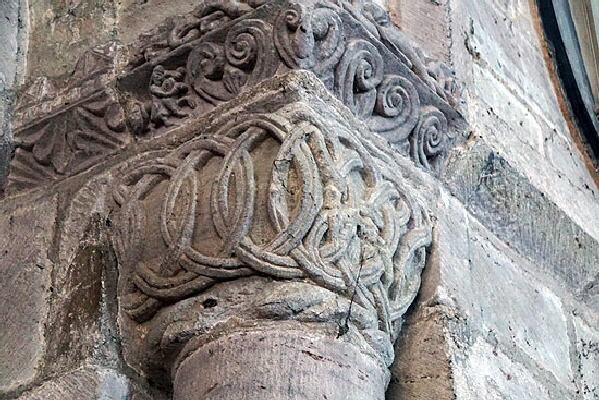 |
||||||||||||||||||||||||||||||||||||||||||
|
Left: A design comprising interlaced rings. Note the design around the top of the capital and the little design of a man astride a horse. Right: The man astride the lion is a representation of Samson and the Lion who he is slaying with his bare hands. Compare this with the Stretton Sugwas tympanum below. |
||||||||||||||||||||||||||||||||||||||||||
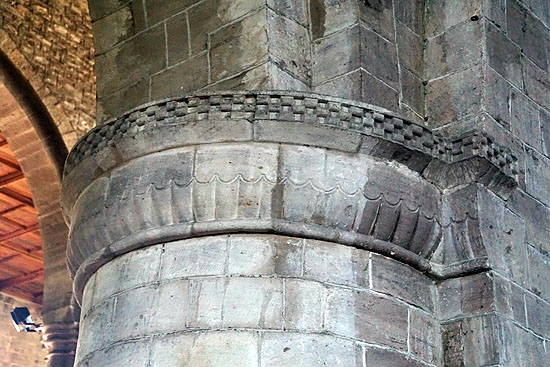 |
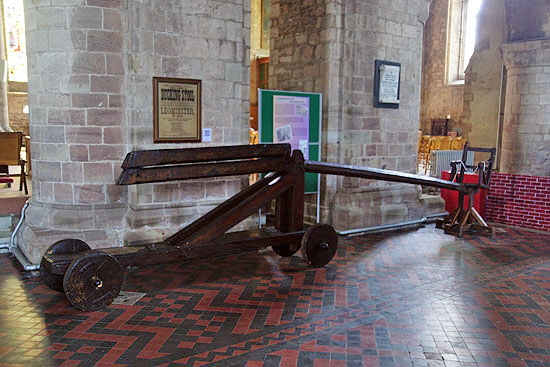 |
|||||||||||||||||||||||||||||||||||||||||
|
Left: One of the capitals of the huge Norman arcades. Right: This, believe it or not, is Leominster’s original ducking stool! It was last used as recently as 1809 for the unfortunate Jenny Pipes. a “vixen”, it was said. There is no doubt that these devices - every manor was required to have one, believe it or not - were used primarily against women, the so-called “scolds” and this is pretty well what I was taught in school a long time ago. Any tradesman who gave short measure or sold spoiled goods could be punished by ducking, however. |
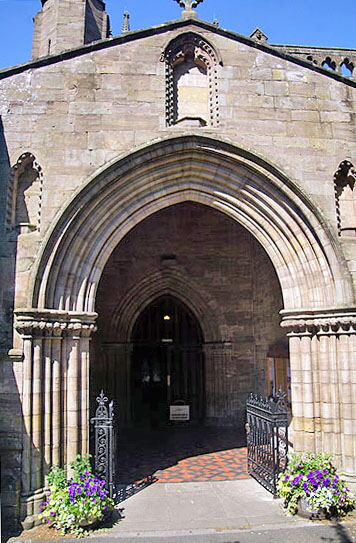 |
|||||||||||
 |
 |
||||||||||
|
Left: The Norman west door and window. Centre: The south door which is of the fourteenth century. Right: The south porch with its empty niches. |
|||||||||||
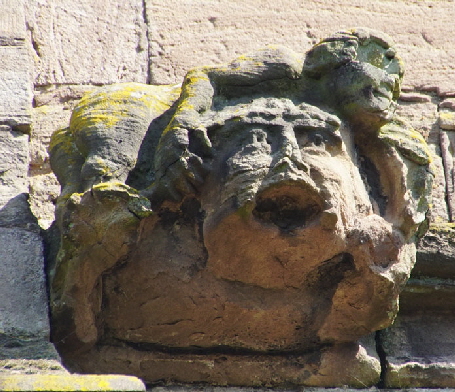 |
|||||||||||
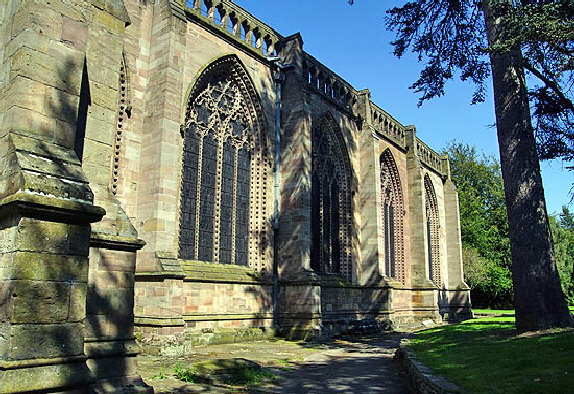 |
|||||||||||
|
Left: The south wall. The Decorated style windows are superb and spectacularly picked out with dog tooth moulding. Right: This grotesque had another bestride him. |
 |
|
On either side of the Norman west window are two spectacular Herefordshire School carvings in very characteristic style. By now you are probably familiar with this conceit of a group of birds within roundels such as we have seen at Rowlestone and Brinsop. The roundels are are being spewed forth from the mouth of a grotesque mask which is an exact copy of one of those on the capitals on the inner west doorway. |
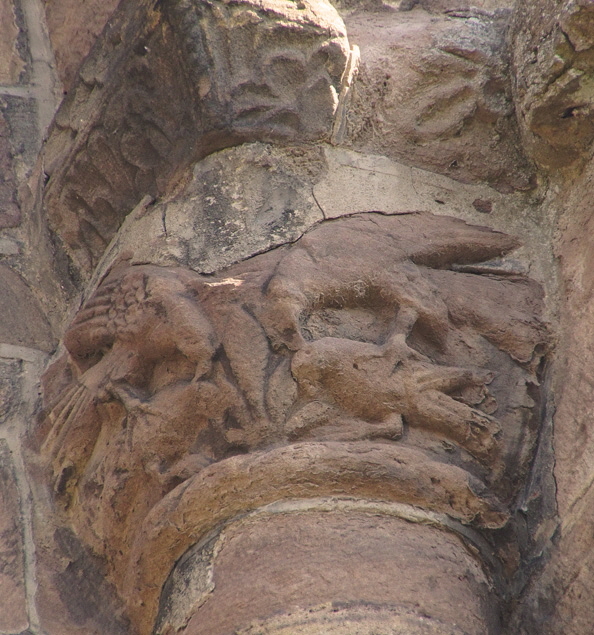 |
|
One the south side of the west window another capital with a bird theme, This time two rage birds are pecking the heads of two smaller ones below them. |
|
|
||||||||||||||||||||||||
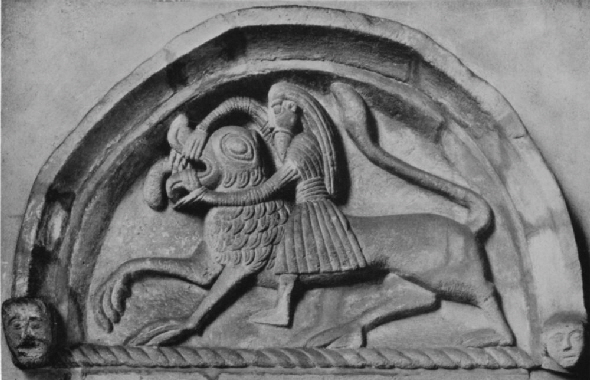 |
|
The tympanum at Stretton Sugwas near Hereford has a Samson and the Lion carving that is clearly similar in form to that on the inner west door at Leominster - note his Samson-like hair just waiting for some kind Delilah to come and give it a trim! The tunic/gambeson that he wears is similar. There are so many similarities in carvings by the Herefordshire School that leave no room for doubt in the existence of this organised group with common artistic values and themes. |
